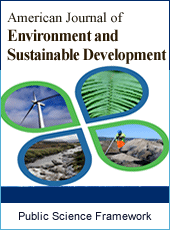American Journal of Environment and Sustainable Development
Articles Information
American Journal of Environment and Sustainable Development, Vol.5, No.2, Jun. 2020, Pub. Date: Jul. 7, 2020
Contribution of Community-Based Disaster Management in Reducing Risks in Rwanda
Pages: 37-42 Views: 1883 Downloads: 290
[01]
Aristarque Ngoga, Faculty of Environmental Studies, University of Lay Adventists of Kigali, Kigali, Rwanda.
[02]
Philbert Mugisha, Faculty of Environmental Studies, University of Lay Adventists of Kigali, Kigali, Rwanda.
[03]
Rosine Rubuga Mukabarungi, Faculty of Environmental Studies, University of Lay Adventists of Kigali, Kigali, Rwanda.
[04]
Elisabeth Yambabariye, Faculty of Environmental Studies, University of Lay Adventists of Kigali, Kigali, Rwanda.
[05]
Lamek Nahayo, Faculty of Environmental Studies, University of Lay Adventists of Kigali, Kigali, Rwanda.
This study assessed the contribution of Community-Based Disaster Management (CBDM) in risk reduction in Ngororero district, western Rwanda. The questionnaire was used to collect data from a sample of 100 respondents selected from total households of the district. The results indicated that landslide is the frequent disaster occurring in this area followed by rainstorms and flood. However, there are no locally-based disaster management groups in Ngororero district. The results by 34 and 32 percent of respondents indicated that the local leaders and District Administration Security Support Organ (DASSO) are the major intervention bodies. These are merely formed and operate during disaster occurrence for the response and recovery activities. Only 14 percent confirmed to carry out disaster risk reduction activities by themselves. This expresses the need of empowering community-based disaster reduction ownership and engagement. This, if initiated, as said by 26%, would strengthen locally-based initiative while 20% said that it could enhance information sharing, mobilization and reporting at community level. It is concluded that there are no CBDMs in Ngororero district and hence, their creation is essential. This can enable policy makers to easily reach the community and ensure community-based policy execution. In addition, these CBDM would assist external agencies in recovery and response activities by precisely heading to the right people in need of assistance.
Community-Based Disaster Management, Disaster Risk Reduction, Ngororero District, Rwanda
[01]
Shaluf IM, Said AM. A review of disaster and crisis. Disaster Prevention and Management: An International Journal 2003.
[02]
Ostadtaghizadeh A, Ardalan A, Paton D, Jabbari H, Khankeh HR. Community disaster resilience: a systematic review on assessment models and tools. PLoS currents 2015; 7.
[03]
Shaw R. Community based disaster risk reduction: Emerald Group Publishing; 2012.
[04]
Victoria LP. Community-based disaster management in the Philippines: Making a difference in people's lives. Philippine Sociological Review 2003; 51: 65-80.
[05]
Luna EM. Community-based disaster risk reduction and disaster management. Disaster Management: Routledge; 2013. p. 65-85.
[06]
Kafle SK. Measuring disaster-resilient communities: a case study of coastal communities in Indonesia. Journal of business continuity & emergency planning 2012; 5: 316-26.
[07]
Paton D, Johnston D. Disasters and communities: vulnerability, resilience and preparedness. Disaster Prevention and Management: An International Journal 2001; 10: 270-7.
[08]
MIDIMAR. The Monthly and Annual Data on Disasters Countrywide. The Ministry of Disaster Management and Refugee Affairs (MIDIMAR). P. O. Box 4386 Kigali, Rwanda. Available at: http://midimar.gov.rw/index.php?id=65, accessed on 14th December, 2017.
[09]
Nahayo L, Li L, Mupenzi C. Spatial Distribution of Landslides Vulnerability for the Risk Management in Ngororero District of Rwanda. 2019.
[10]
NISR. National Institute of Statistics of Rwanda. Population and Housing Survey. Kigali, Rwanda. 2012.
[11]
MINEMA. Ministry in Charge of Emergency Management, Disaster Management Information System, Kigali, Rwanda. 2020.
[12]
Habiba U, Shaw R, Abedin MA. Community-based disaster risk reduction approaches in Bangladesh. Disaster risk reduction approaches in Bangladesh: Springer; 2013. p. 259-79.
[13]
Dufty N. Using social media to build community disaster resilience. Australian Journal of Emergency Management, The 2012; 27: 40.
[14]
Liu Y, Yin K, Chen L, Wang W, Liu Y. A community-based disaster risk reduction system in Wanzhou, China. International journal of disaster risk reduction 2016; 19: 379-89.
[15]
Karvinen I, Lejonqvist GB, Kinnunen ER, Fredriksson M, Halonen R, Koski A. A study of the community‑based disaster preparedness in Kenyan rural communities. 2016.
[16]
Siagian TH, Purhadi P, Suhartono S, Ritonga H. Social vulnerability to natural hazards in Indonesia: driving factors and policy implications. Natural hazards 2014; 70: 1603-17.
[17]
Jahangiri K, Izadkhah YO, Tabibi SJ. A comparative study on community‐based disaster management in selected countries and designing a model for Iran. Disaster Prevention and Management: An International Journal 2011.
[18]
Amri A, Bird DK, Ronan K, Haynes K, Towers B. Disaster risk reduction education in Indonesia: challenges and recommendations for scaling up. Natural Hazards and Earth System Sciences 2017; 17: 595.

ISSN Print: Pending
ISSN Online: Pending
Current Issue:
Vol. 6, Issue 4, December Submit a Manuscript Join Editorial Board Join Reviewer Team
ISSN Online: Pending
Current Issue:
Vol. 6, Issue 4, December Submit a Manuscript Join Editorial Board Join Reviewer Team
| About This Journal |
| All Issues |
| Open Access |
| Indexing |
| Payment Information |
| Author Guidelines |
| Review Process |
| Publication Ethics |
| Editorial Board |
| Peer Reviewers |


